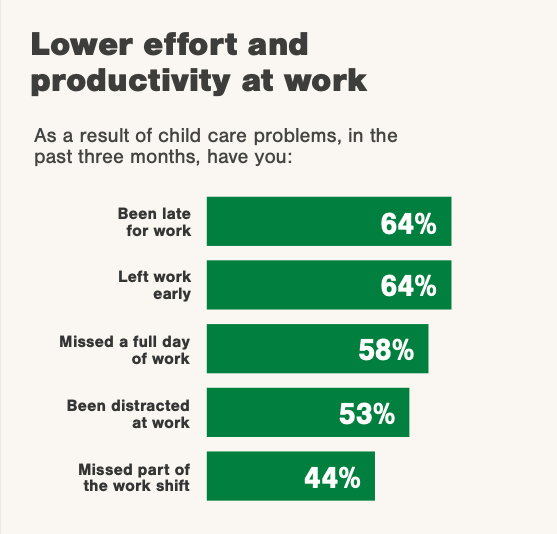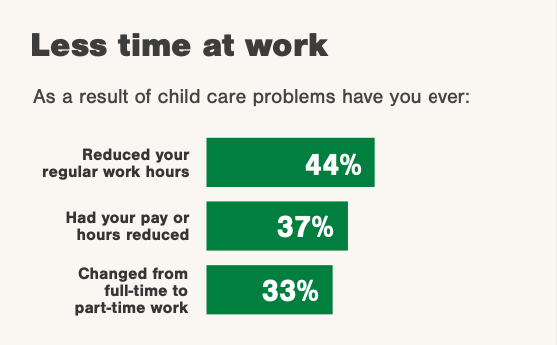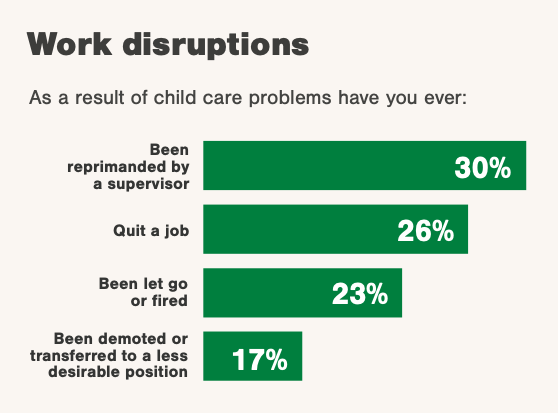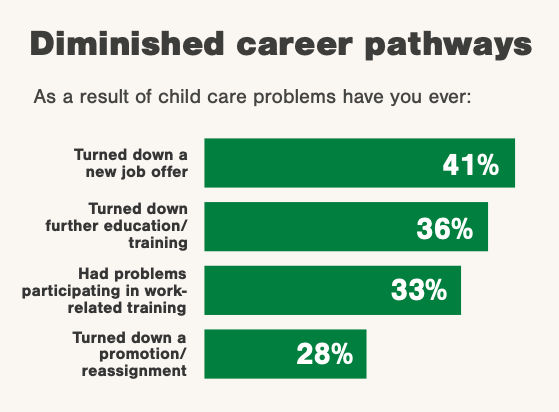

Share this story
- A new report from @Ready_Nation finds the infant-toddler child care crisis is costing North Carolina $3.5 billion every year.
- “If there’s a more bipartisan issue than taking care of toddlers, I don’t know what it is." Business leaders ask Congress to address the infant-toddler child care crisis, which costs the nation $122 billion annually.
|
|
A report released this week found the annual cost of the infant-toddler child care crisis is $122 billion nationwide. In North Carolina alone, the cost is $3.5 billion.
ReadyNation, a national bipartisan nonprofit organization of business executives, presented its report at a congressional briefing that included a panel discussion in Washington, D.C. on February 2.
“I’m here to respectfully ask our federal lawmakers to increase investments in early childhood education and child care, and make it more affordable and accessible for families,” Katie Ferrier, vice president of education and workforce development at the San Antonio Chamber of Commerce, said at the briefing. “We need to help stabilize the child care industry, support innovation, build capacity, and ensure taxpayer dollars are being used for quality. America’s economic success depends on us.”
Jack McBride, founder and CEO of Contec Inc., a manufacturer based in Spartanburg, South Carolina, expressed optimism for progress on the issue. “If there’s a more bipartisan issue than taking care of toddlers, I don’t know what it is.”
The study
The report is based on a study conducted on behalf of ReadyNation in December 2022. A nationally representative sample of 806 parents participated, all of them parents of children under age 3. Fifty-five percent of participants identified as mothers and 45% as fathers.
The vast majority — almost 75% — reported challenges accessing child care, and more than half reported challenges finding care that was high quality or affordable.
More than 30% “had difficulty finding care that was in a convenient location, available outside Monday-Friday daytime hours, had flexible hours, had open slots, or was available on an emergency/sick child basis,” the report says.
To learn how the infant-toddler child care crisis affects the economy, researchers merged the survey data with labor market data.
The report is an update to a similar 2018 report from ReadyNation. At that time, the cost of the child care crisis was estimated at $57 billion annually. The authors of the new report say the COVID-19 pandemic and “insufficient policy action” have “significantly worsened the crisis.”
“I warned my colleagues at the Council for a Strong America, it may not be that much of a financial increase [from 2018] because parents find a way,” lead author Sandra Bishop told the audience at Thursday’s congressional briefing. “But I was dead wrong.”
The issue
According to the report, “The majority of American parents with very young children are now in the workforce. There are approximately 11.4 million children under the age of 3 across the nation, with 14.1 million working parents.”
In North Carolina, according to a November 2022 report from the North Carolina Early Childhood Foundation (NCECF), “Approximately 400,000 working parents across NC are assumed to be constrained by child care needs, given that there are an estimated 610,000 children, aged 0-5 years.”
Like the authors of the NCECF report — and recent reporting from EdNC — the authors of the ReadyNation report explain that policies supporting access to affordable, high-quality child care have an economic impact on two generations.
Parents benefit from child care by being able to build successful careers that support their families. Infants and toddlers benefit from being in child care settings that nurture the crucial brain development occurring in the first three years of life, building the foundation for their future education and workforce participation.
“The current child care system does not meet the needs of families or employers,” the authors of the ReadyNation report say. As evidence, they offer the following details about accessibility, affordability, and quality of child care:
- More than half of U.S. residents (51%) live in a child care “desert” where there are more than three children under age 5 for every licensed child care slot.
- Availability is especially limited for families who have infants and toddlers, have low incomes, work non-traditional hours, or live in rural areas.
- The average cost of center-based care for infants is more than in-state, public college tuition in 34 states (including North Carolina) and the District of Columbia.
- High rates of provider turnover, due in large part to inadequate compensation, lead to a lack of stable, consistent caregiving.
Impacts on parents and families
Based on the survey results, the authors found families lose an average of $5,520 annually per working parent in lost earnings and time spent looking for work. Nationally this amounts to $78 billion each year.
The survey found that parents with infants and toddlers have lower efforts and productivity at work, spend less time at work, experience disruptions to work, and have diminished career pathways — all due to the child care crisis.
Specific survey results can be seen below:








Panelists at the briefing highlighted the ways these disruptions have economic ripple effects over time.
“Parents are making choices right now,” Ferrier said. “They’re choosing not to take that promotion. They’re choosing not to pursue that degree, and it’s going to have long-term implications for their careers.”
The authors of the report found, “Disruptions to parents’ work lives due to child care challenges are much worse and more widespread now, compared to 2018.” They offer the following details as evidence:
- Percentages of parents reporting each negative impact of insufficient child care are higher now than in 2018 for virtually all impacts.
- Parents reported the infant-toddler child care crisis had caused them to be fired or have pay or hours reduced nearly three times more often in 2022 than in 2018.
- The crisis caused parents to be demoted or transferred to a less desirable job, or change from full-time to part-time work more than twice as often.
- Rates of parents reporting quitting due to child care problems doubled.
Impacts on employers and taxpayers
According to the report, employers and businesses lose an average of $1,640 per working parent annually in reduced revenue and hiring costs. That amounts to $23 billion nationally.
When an employer’s workforce is in flux, the authors say, it hurts worker morale, product quality, and client relationships that can lead to lower revenue. Direct costs can be felt immediately in recruitment, hiring, and training due to high turnover. Future costs also can be affected when workers lack proper training or are inexperienced.
The authors say that taxpayers lose an average of $1,470 per working parent annually due to lower income and sales tax revenue. They point out that these effects are long-term due to parents’ decreased earning potential. Scaled to the national level, that’s $21 billion in lost tax revenue every year.
When Megan Leonhardt, a writer for Fortune magazine and moderator of the panel, asked Bishop to imagine the future of the infant-toddler child care crisis given the changes between 2018 and 2022, Bishop responded, “I can’t imagine that it’s not going to get worse.”





